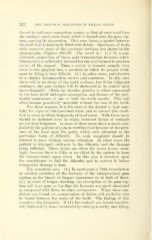Page 466 - My FlipBook
P. 466
212 THE TECHNICAL PROCEDURES IN FILLING TEETH.
forced in and more separation occurs, so that at each meal-time
the surfaces catch more food, which is forced onto the gum sep-
tima, causing its absorption. This soon forms a pocket between
the teeth that is habitually filled with debris. Specimens of teeth
with excessive wear of the jjroximal surfaces are shown in the
photographs. Figures 293-297. The result is: (1.) In a con-
siderable proportion of these, acid fermentation becomes estab-
lished and it is sufficiently inclosed for the acid formed to produce
caries of the enamel. Then a cavity is formed, usually very
close to the gingival line, a position in which its proper treat-
ment by filling is very difficult. (2.) In other cases, putrefactive
or a similar decomposition occurs and continues. In this case
there will he no decay of the tooth surfaces, but if the lodgment
continues, the gum septum will be destroyed in its central area
bucco-lingually. Often the alveolar process is either uncovered
or the bone itself undergoes absorption, and disease of the peri-
dental membranes of one or both the teeth results. This will
often become practically incurable without the loss of the teeth.
For these reasons, it is the duty of the dentist to look care-
fully for signs of interproximal wear, and to correct this condi-
tion in cases in which lodgments of food occur. With these cases
should be included cases in which incorrect forms of contacts
permit food lodgment. In some of these cases there is much com-
plaint by the patient of pain in chewing food because of the pres-
sure of the food upon the gums, which calls attention to the
particular form of difficulty. No such complaint should be
allowed to pass without serious attention. In other cases the
patient is strangely oblivious to the difficulty and the damage
being inflicted. These latter are often the worst forms seem-
ingly, because there is little or no effort by the patient to keep
the interproximal space clean. In this case it devolves upon
the jjractitioner to find the difficulty and to correct it before
irreparable damage is done.
The sjTuptoms are: (1.) In most cases a little tumefaction
or swollen condition of the festoons of the interproximal gum
septum in the buccal or lingual embrasure or in both of these.
(2.) In cases of longer standing, the absorption of the gum sep-
tum will have gone so far that the festoons are much shortened
as compared with those in other embrasures. When these con-
ditions are found, an accumulation of debris will probably also
be found between the necks of the teeth. The finding of this
com])letes the diagnosis. If (1) the contacts are found consider-
ably flattened by wear, treatment by cutting a cavity and filling,


